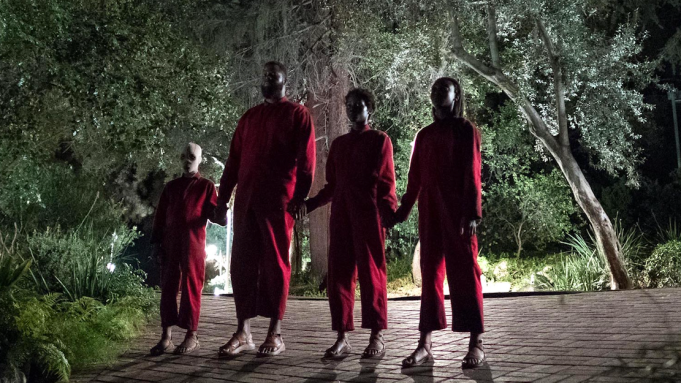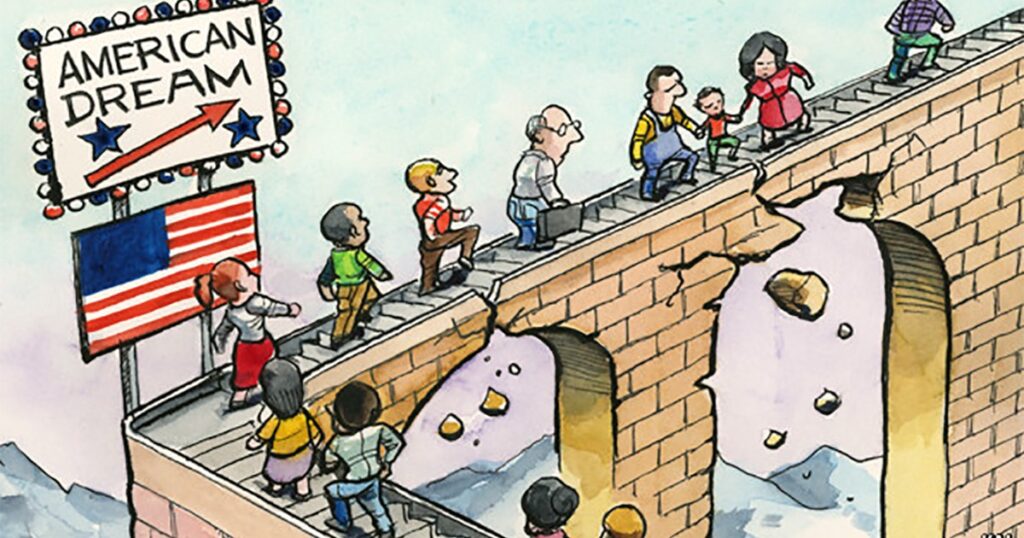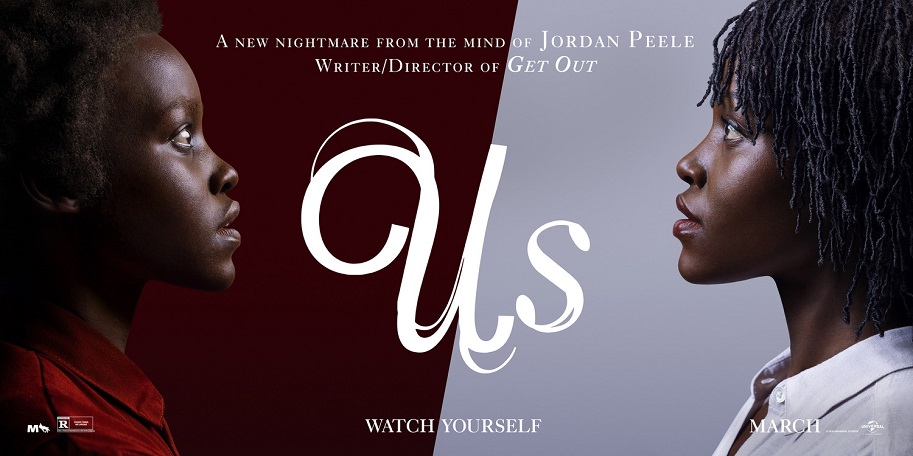By Penny Theodorakopoulou,
Recently, I watched Jordan Peele’s Us (2019), the same person who directed, wrote and produced the movie Get Out. With Peele being the writer, producer, and director once more, his movie Us is considered a “hard” movie; and when I say that it is a hard movie, I mean that it requires a lot of thought, and even some research, to appreciate and understand it. Comparing Us to Get Out, we cannot claim that it is a horror movie in its classic term — by having massacres, bloodbaths, jump scares, etc. The horror of this movie lies in something else than your typical horror movie, the American Dream and its failure.
Before I talk about the failure of the “American Dream” depicted in Us, it would be appropriate to refer to its plot briefly. The movie initially takes place in 1986 in Santa Cruz, where Adelaide (Lupita Nyong’o) went to a House of Mirrors. There, she met her doppelganger who choked her, causing a serious childhood trauma. A few years later, we see Adelaide having a (seemingly) perfect family: her loving husband, Gabe (played by Winston Duke), her daughter, Zora (played by Shahadi Wright Joseph), and her son Jason (Evan Alex), all living in a nice summer house.
That “perfect” American life changes on the first night at the summer house, where they meet their doppelgangers. Those doppelgangers are called “The Tethered”, who have spent all their lives under their hosts’ shadows, and have now risen to the surface to “untether” themselves from their hosts. Many murders take place during the movie. However, the most shocking part of the movie, making Us an incredible and plot-twist-worth movie, is the fact that Adelaide is the actual Tethered and not Red, the doppelganger. The Tethered Adelaide switched places with Red, the “original” Adelaide, back in the House of Mirrors; hence Red is the only capable Tethered of speaking, even with a cracked voice, due to the Tethered Adelaide choking her when she was a child.
Throughout the years, the term “American Dream” has piqued my interest, but I never really engaged in finding more information about that term, until now. For those who are not familiar with the aforementioned term, American Dream refers to, in sum, the equal opportunity all American citizens have to achieve their version of success in society, no matter the circumstances of birth, social, or financial class. The movie presents to its viewers, however, that America is often considered superficial not only figuratively, but also literally. There is nothing under the surface. It is empty and hollow. All America is, is on the surface, and underneath there is no actual meaning or essence.

A great example of what was just mentioned is the Hands Across America campaign, which took place on May 25, 1986, when the movie starts. Hands Across America involved 15 minutes of people holding hands across the country to raise money to “cure homelessness and hunger”. It happened at the height of the Reagan era, which was a time marked by a lot of national growth and an ‘80s-tastic feeling of positivity on one hand, but also blind unchecked capitalism and business wheeling and dealing on the other, and nothing shows this better than Hands Across America. The event itself managed to raise a massive amount of money — 32 million dollars, to be exact —, which is great, especially for the standards back in the ‘80s, until you consider that the company that ran this campaign used 17 million of those dollars to pay its bills, so the homeless saw much less of that total amount than it initially seemed. In general, when it comes to charitable events, any “administration fees” over 20% are considered to be pretty egregious.
From the beginning of the movie, we see what appears to be a great moment of union among American citizens that looks extraordinary on the outside and emotionally moving. However, is already questionable regarding what lies under the surface. It looked great on the surface, but when it came to actual substance, it, once again, is empty.
Empty and without substance is the life of the people in the movie. Jordan Peele has chosen to include a plethora of symbols that show the failure or letdown of the American Dream. Throughout the movie, Gabe, Adelaide’s husband, wears a Howard University sweatshirt, which, if you are not familiar, is a historically black college, along with other high-end universities like Hampton and the Tuskegee Institute. These schools are all part of the black Ivy League, a group of prestigious schools that were specifically available to African Americans back when segregation was still a thing. So, on one hand, they represent every American dreams of: going to a good college, the Ivy League, but on the other hand, it is a group of schools that specifically came out of segregation. A dark spot on America’s past, and part of a long history of racial inequality. For some time, these schools were also considered to be the schools that black students could go to, that would qualify them for careers that were traditionally considered “beyond the reach” of African Americans at the time; jobs only available to upper-middle-class white people. It is the American Dream again but twisted and corrupted.

Since we are talking about Gabe, let us talk about Gabe’s boat. Throughout the movie, we see a lot of characters that have numerous nice stuff in their possession; and having nice stuff is something we all want, and something people are currently obsessed with, from flex culture to Yeezys. However, in Us, we see that it is not quite working the way that everyone hopes. If you are a middle-class person in the U.S., there is a good chance that your dad dreamed of buying a boat at some point or another. It is the ultimate symbol of expendable income: something purely for relaxation that costs a lot to maintain and that you use once or twice a year, perhaps. And here Gabe is, achieving the dream, checking off the “I am on a boat” box, but the boat does not function properly — it turns off randomly and it pulls to the left. Yet again, it is the American Dream in name, but in substance, it is empty.
The American Dream is not a destination. It is just constantly trying to get more than you already have, and constantly being dissatisfied by what you do have. Materialism is the shield; it is the solution because it is always the solution in America. The irony is that all the stuff that the characters in the movie possess is not protecting anyone, but rather killing everyone. Even Tethered Kitty and Josh Tyler, Adelaide and Gabe’s white friends, cannot resist the pull of capitalism: they put on the bathrobe, they put on makeup, even try a little DIY plastic surgery in pursuit of this beautiful life that their hosts, the real surface Tylers had. They think that it will be the thing that makes them happy, that gives them substance. The irony is, it is not going to make them happy, because, as Childish Gambino said in a quite popular song of his, “This is America”.
References
- How Jordan Peele’s Us Deconstructs the American Dream & Capitalist Consumption, geekappetite, Available here
- Us Movie Ending Explained: Symbolism, Themes & Easter Eggs, studiobinder, Available here
- Us’s big plot twist, explained, vox, Available here
- Us (2019 film), wikipedia, Available here




